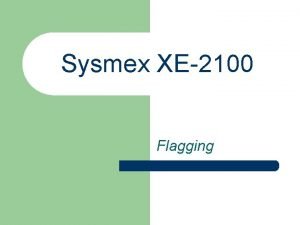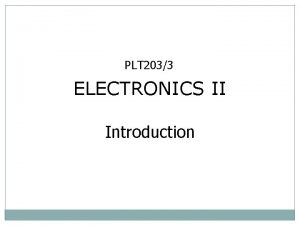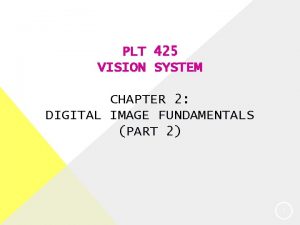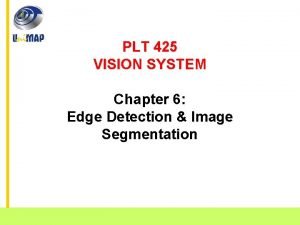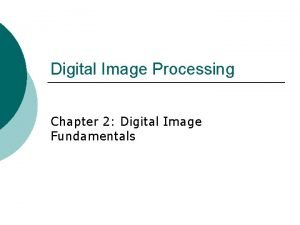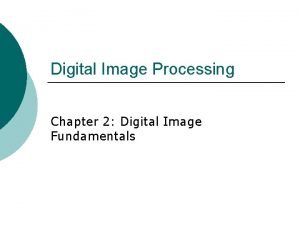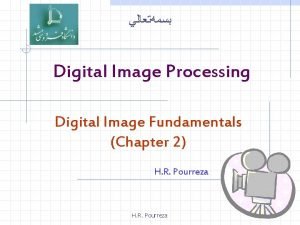PLT 425 VISION SYSTEM CHAPTER 2 DIGITAL IMAGE




















- Slides: 20

PLT 425 VISION SYSTEM CHAPTER 2: DIGITAL IMAGE FUNDAMENTALS (PART 1) 1

CONTENTS q Elements of Visual Perception § Structure of the human eye § Image formation in the eye q Image Sensing and Acquisition § Image acquisition usingle sensor § Image acquisition using sensors strips § Image acquisition using sensors array § A simple image formation model q Basic Relation between Pixels § Neighbors of a pixel § Distance measures 2

ELEMENTS OF VISUAL PERCEPTION Structure of the Human Eye Ø Digital image processing is built on a foundation of mathematical and probabilistic formulas. Ø To understand image processing – consider first our human vision system. Ø Observe and evaluate images in our own biological system to avoid misinterpretation of how images are formed. 3

Figure 2. 1: Human eye cross section 4

ELEMENTS OF VISUAL PERCEPTION Image Formation in the Eye Ø Light enters through cornea. Ø Passes through aqueous humor, the Ø Ø lens and vitreous humor. Finally forms an image on the retina. Lens adjusts and focus image directly on retina. Retina is a complex tiling of photoreceptors known as rods and cones. When stimulated by light they produce electrical signals that are transmitted to the brain by the optic nerve. 5

Ø The distance between the lens and the imaging region (the retina) is fixed and the focal length needed to achieve proper focus is obtained by varying the shape of the lens. Ø The distance between the center of the lens and the retina along the visual axis approximately 17 mm. Ø For example: A person is looking at a tree 15 m high at a distance of 100 m. Letting h denote the height of that object in the retinal image, 15/100 = h/17, h= 2. 55 mm. 6

IMAGE SENSING AND ACQUISITION Ø Image acquisition is the first stage of a vision system. Ø It is the action of retrieving an image from some source, usually a hardware-based source. Ø Acquired image is dependent on: – Nature of sensing device • Charge-coupled device (CCD), infra red, grayscale, color 7

IMAGE SENSING AND ACQUISITION Ø Acquired image is dependent on: – Properties of the device • Sensitivity, resolution, lenses, stability , focus – The lighting of the scene • Shadows, excessive reflection, poor contrast – The environment • Dust, fog, humidity – The reflective properties of the objects • Texture, color 8

IMAGE SENSING AND ACQUISITION Ø Image is generated from two main sources: illumination levels and reflection or energy absorption. Ø Illumination may originate from a source of electromagnetic energy, such as radar, x-ray, infrared, etc. Ø Example: § Light reflected from planar object (reflection) § X-ray pass through patient body (absorption) Ø There are 3 principle sensors arrangement to convert these illumination energy into digital images: § Image acquisition usingle sensor § Image acquisition using sensors strips § Image acquisition using sensors array 9

Images are typically generated by illuminating a scene and absorbing the energy reflected by the objects in that scene 10

Imaging sensor Incoming energy lands on a sensor material responsive to that type of energy and this generates a voltage. Collections of sensors are arranged to capture images. Line of image sensors Array of image sensors 11

Image Acquisition using Single Sensor Ø Example: photodiode, constructed using silicon materials whose output voltage is proportional to light. Ø To generate 2 D image, relativity displacement of x- and y- directions between the sensor and area to be images. 12

Image Acquisition using Sensors Strips 13

Image Acquisition using Sensors Array Ø Predominant arrangement in today’s camera. Ø Typical sensor: Charge-coupled device (CCD). Ø The response of each sensors is proportional to the integral of the light energy projected onto the surface of the sensor. 14

Example of the Digital Image Acquisition Process using Array Sensors http: //legendtechz. blogspot. my/2013/03/5 -explain-process-ofimage-acquisition. html 15

GENERATING A DIGITAL IMAGE Ø The output of most sensors is a continuous voltage waveform. Ø To create a digital image, convert the continuous waveform into digital form. This involves two processes: sampling and quantization. Ø Sampling – The sampling rate determines how many pixels the digital image will have (the image resolution). Ø Quantization – Determines how many intensity levels will be used to represent the intensity value at each sample point. 16

Image Sampling Ø Continuous images are sampled to convert them to digital form. Ø Each image sample is called a pixel (picture element). Ø Sampling is the process of representing a continuous signal by a set of samples taken at discrete intervals of time (sampling interval). Sampling Frequency Continuous Signal Sampled Signal 17

Image Quantization Ø Quantization is the process of converting analog pixel intensities to discrete valued integer numbers. Ø Quantization involves assigning a single value to each sample values in such a way that the image reconstructed from quantized values is good. 18

Image Sampling and Quantization 19

Ø Figure (a) represents an analog miniature young starfish image of an optical microscope. Ø After sampling in a two-dimensional array, the resulting data is quantized to assign a specific digital brightness value to each sampled data point, ranging from black, through all of the intermediate gray levels, to white. Ø The result is a numerical representation of the intensity, which is commonly referred to as a picture element or pixel, for each sampled data point in the array. 20
 Translate
Translate What is image restoration in digital image processing
What is image restoration in digital image processing Compression in digital image processing
Compression in digital image processing Image segmentation in digital image processing
Image segmentation in digital image processing Analog image and digital image
Analog image and digital image Fidelity criteria in digital image processing
Fidelity criteria in digital image processing Image sharpening in digital image processing
Image sharpening in digital image processing Geometric transformation in digital image processing
Geometric transformation in digital image processing The range of values spanned by the gray scale is called
The range of values spanned by the gray scale is called Image transforms in digital image processing
Image transforms in digital image processing Image geometry in digital image processing
Image geometry in digital image processing Image restoration in digital image processing
Image restoration in digital image processing Lymphl
Lymphl Sysmex xe2100
Sysmex xe2100 Plt 404
Plt 404 Striscio di sangue
Striscio di sangue Plt scheme
Plt scheme Plt fuzzy set
Plt fuzzy set Plt electronics
Plt electronics Plt 106
Plt 106 Extra high voltage
Extra high voltage












